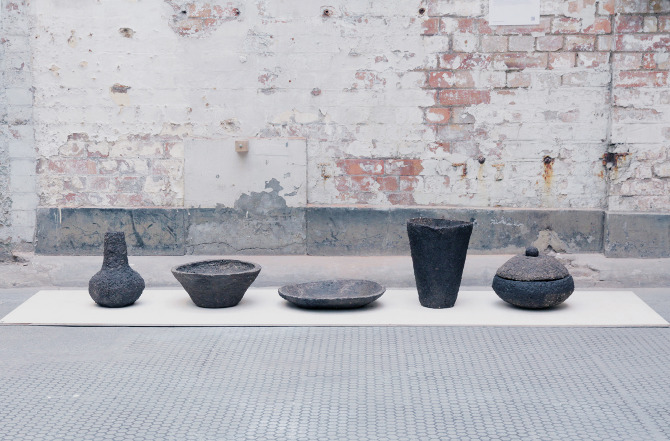The five pots and plates that are a result of Hilda Hellström’s conceptual design project, The Materiality of a Natural Disaster, are lumpy and misshapen and look like they might crumble at any moment; they look unfit—and they are. They are made from soil and clay from the Fukushima-Daiichi exclusion zone in Japan, the 12 mile (20 km) radius that has been cordoned off as a result of the Fukushima Daiichi nuclear disaster that followed a tsunami on March 11th, 2011. The vessels are irradiated, but within “allowable” levels. Hellström dug up the soil for them with Naoto Matsumura, a former rice farmer and the last resident living inside the exclusion zone.
The other component of The Materiality of a Natural Disaster is a 12-minute video (which is embedded below) that Hellström made which documents Naoto Matsumura’s life inside the exclusion zone. Matsumura lives there alone, without water or electricity, on his land that won’t be farmable for at least thirty years. The film doesn’t speculate about Matsumura’s reasons for staying but he says in the film, “I don’t die easily, so I stayed to feed the animals.”
The following is an excerpt from a longer text that Hellström wrote about The Materiality of a Natural Disaster:
The project wasn’t an attempt to help or to save Matsumura: the last person I know who would want to be saved. Instead, going there was a kind of anthropological case study; a way to relate to the reality we live in. I wanted to tell the story of one man’s fate, and investigate whether this was possible to realize through the medium of objects.
The project is rather literal in the sense that I was making rice bowls that you can’t eat off, from soil you can’t grow rice in, to facilitate the much more daunting discussion about the agriculture. Just in the same way as religious symbols make concrete abstract thoughts, I wanted to look into how a concrete manifestation might provoke something more profound in people than what is achievable by words alone.
The video begins with a drive though Tomioka, a small city within the exclusion zone. The town is deserted but seems intact. Initially, Hellström shows abandoned, everyday objects. As the video continues the scenery become increasingly disheveled, crops are wasting in the fields and cattle carcasses rot in the stables where the animals were abandoned. By the end, the destruction on display is wholesale, houses are destroyed and their contents are thrown together and intermingled. The sheer materiality is a visceral experience; Hellström has made manifest the destruction that is visible and the destruction that can’t be seen, which will last indefinitely and is irreversible.
Hilda Hellström is a Swedish designer who lives and works in London. She graduated from Royal College of Art’s Design Products program in 2012 and received her BFA in Product Design from Beckmans College of Design, Stockholm in 2010. Her recent exhibitions include Mastering Design, MUDAC, Switzerland (2013); Passionswege,Vienna Design Week, Austria (2013); The Future Perfect, ICFF New York, US (2013); Örnsbergsauktionen, Stockholm Design Week, Sweden (2013); Contemporary Collected, Tokyo Design Week, Japan (2012); RCA Paradise, Milan Furniture Fair, Lambrate, Italy (2012)
Amy Albracht is a General Editor at CFile.
 Video still from Hilda Hellström’s The Materiality of a Natural Disaster (2012) showing the artist collecting irradiated soil with Naoto Matsumura, a rice farmer and the last resident living inside the Fukushima-Daiichi exclusion zone
Video still from Hilda Hellström’s The Materiality of a Natural Disaster (2012) showing the artist collecting irradiated soil with Naoto Matsumura, a rice farmer and the last resident living inside the Fukushima-Daiichi exclusion zone


above: Hilda Hellström, food vessels from The Materiality of a Natural Disaster (2012), made from clay and soil from a rice field inside the Fukushima-Daiichi exclusion zone.

Video still from Hilda Hellström’s The Materiality of a Natural Disaster that shows a deserted stable inside the Fukushima-Daiichi exclusion zone
Hilda Hellström’s film, The Materiality of a Natural Disaster (2012)

Add your valued opinion to this post.